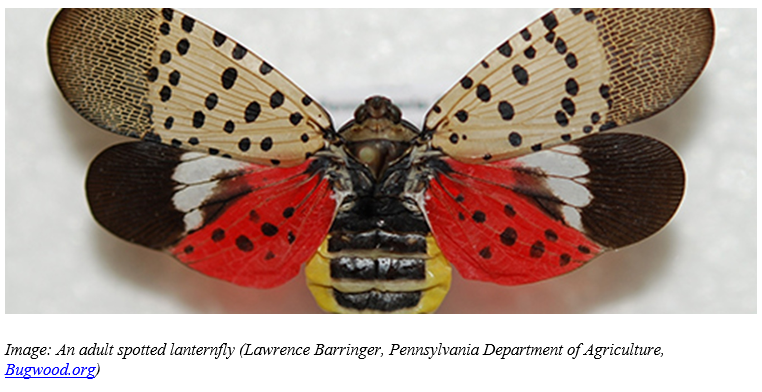Status
COMPLETE
Project Leader
Dr Olivia Reynolds (CesarAustralia)
Executive Summary
Incursions of exotic pest species place pressure on biosecurity resources globally and measures to understand and prepare for priority exotic pests are a crucial aspect of any biosecurity system. Global costs associated with incursions of exotic pest species have been estimated to have reached at least US$1.288 trillion from 1970-2017 according to a study by Diagne et al., (2020).
The spotted lanternfly, Lycorma delicatula (White) (Hemiptera: Fulgoridae), is a hemimetabolous insect that is native to China, Vietnam & India. In 2004, the first specimen-confirmed report of this pest outside its native range was from South Korea, followed by sudden L. delicatula outbreaks in Hakusan, Japan in 2008, although sporadic occurrences were thought to have occurred within limited geographic areas since the 1930’s. In 2014, L. delicatula invaded North America, Berks County, Pennsylvania, US, and has since spread to several other states. This invasive pest is not currently known to occur in Australia.
The Australian Plant Biosecurity Science Foundation and the Chief Environmental Biosecurity Office, Department of Agriculture, Water and the Environment contracted Cesar Australia to undertake a review of L. delicatula’s biology, host plants, invasive pathways and management in addition to the potential seasonal distribution of the pest in Australia. Further, development of educational resources and targeting of high influence communication pathways undertaken during this project support wide dissemination of the project outputs. Resources were supplied to project partners that included Ms Jo Chong Wah and Sarah Brown, Urban Plant Health Network (Agriculture Victoria), Dr Angus Carnegie, New South Wales Department of Primary Industries (NSWDPI), Dr’s Daniela Carnovale and Sharyn Taylor, Botanic Gardens Biosecurity Network (Plant Health Australia) and Ms Michelle Smith and Ruth Luckner, Peri-urban Environmental Biosecurity Network (NSW Department of Primary Industries), and Mr John McDonald (Greenlife Industry Australia).
The review into L. delicatula resulted in an output in which the most current knowledge of L. delicatula phenology, host plants, surveillance options and management was compiled, with key insights included below.
- Lycorma delicatula has over 180 recorded host plants. The ‘Tree of Heaven’ (Ailanthus altissima) (Mill.) Swingle (Simaroubaceae), a preferred host plant, is widely naturalised throughout the coastal and sub-coastal regions of south eastern Australia and is regarded as an environmental weed in most states and territories. Should the pest incur, its potential host plant range is likely to expand due to the unique Australian flora that does not occur within its current distribution.
- In Australia, as in other parts of the world, L. delicatula is likely to complete only one generation per year (univoltine) over much of its range, although it remains unconfirmed whether the pest is multivoltine in warmer climates.
- Lycorma delicatula is a known ‘hitchhiker’ due to its non-discriminatory egg laying behaviour. Eggs laid on containers and their contents, vehicles, machinery, equipment, nursery stock, fresh produce, cut flowers and foliage, forest products and passenger luggage have the potential to be transported into Australia.
- Adult spread occurs through flight, typically only moving 10-50 m, launching themselves from trees, and other indiscriminate objects. Environmental DNA studies suggest that nymphs may move between hosts more frequently than originally thought.
- The damage caused by L. delicatula results from feeding on the phloem of host plants, causing oozing wounds, increasing the risk of secondary impact from disease. The pest excretes large amounts of honeydew when it feeds, promoting the growth of sooty mould that hinders plant photosynthesis and contaminates agricultural and forest crops. This also attracts nuisance pests such ants and wasps.
- In Australia, the pest is expected to be a threat to the nursery, fruits, landscape and hardwood industries. Impacts can also be expected on the livelihoods of local producers and businesses and the quality of life of the residents as it is a nuisance pest on people’s properties, congregating on wood piles, garden furniture, fence posts and other inanimate objects.
- A key gap in the surveillance and monitoring of L. delicatula is the lack of sensitive sampling/trapping techniques that can detect low population densities, although recent advances in the use of environmental DNA are promising.
- Citizen science can play a significant role in early detection and reporting of the pest, given its conspicuous appearance.
- Current management options are limited, as most of the available information is from invaded regions that are still grappling with the lack of knowledge, and numerous research gaps exist for this pest. Control programs are largely chemical focused, and are likely to remain so until further cultural, genetic and biological options are available.
In addition to the review, a more complete understanding of the seasonal distribution and development of L. delicatula in Australian environments was achieved through prediction modelling. This activity provided insights into likelihood of L. delicatula survival and development times for Australia. For southern Australia, nymph emergence has been predicted to occur from November with adult development complete in most regions by March. Development is predicted to be delayed in high altitude regions of Australia’s southeast, with nymphal emergence not occurring until after January. By April, survival is estimated to be highest in southern coastal regions. In Tasmania, hatching is not predicted to occur in many western areas where temperatures remain too cool.
Sub-tropical latitudes and associated temperatures generally appear suitable for L. delicatula development based on laboratory studies, despite few occurrence records in these regions globally, although A. altissima, a preferred host,is not found in tropical regions.
The third component of this project involved extension of key information related to L. delicatula preparedness, detection and management. Steps towards pre-emptively engaging the public, as well as at risk businesses, on the topic of L. delicatula identification, reporting, and transmission risk reduction have been undertaken during this project. Continuing to raise awareness, particularly among influential stakeholders, will be an important contributor to improving the chance of early detection and limiting risk of transmission. Within this project key influencers and high potential detector groups have been identified, and resources developed and provided to support future education, awareness and monitoring efforts.
Initial investment is required to ensure preparedness for this pest, including monitoring, surveillance and diagnostics at our border. Research is required to better understand the biology and ecology of the pest and how it might behave under Australian conditions, and to identify potential biological controls already found in Australia. Forming key relationships with international experts that can be called upon should the pest arrive would be advantageous.
The full report can be found here, and the journal preprint online here.

